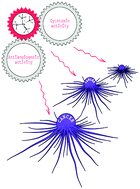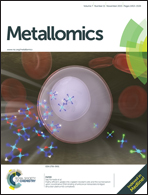Homoleptic phosphino copper(i) complexes with in vitro and in vivo dual cytotoxic and anti-angiogenic activity†
Abstract
Homoleptic, tetrahedral Cu(I) complexes of the type [Cu(P)4]BF4 (1–3), where P are the phosphine ligands, 1,3,5-triaza-7-phosphaadamantane (PTA), 3,7-diacetyl-1,3,7-triaza-5-phosphabicyclo[3.3.1]nonane (DAPTA) and 2-thia-1,3,5-triaza-phosphoaadamantane-2,2-dioxide (PTA-SO2), have been prepared. Novel complexes [Cu(DAPTA)4]BF42 and [Cu(PTA-SO2)4]BF43 have been fully characterized by means of spectroscopic methods, corroborated by XAS-EXAFS analysis of 2. In vitro cell culture experiments revealed a significant antiproliferative activity for Cu(I) compounds against several human cancer cell lines derived from solid tumors with preferential cell growth inhibition towards tumour compared to non-malignant cells. In vitro monitoring of migration and capillary-like tube formation of human umbilical vein endothelial cells (HUVECs) showed an anti-angiogenic effect of copper(I) complexes at sub-cytotoxic concentrations. In vivo studies on the antitumor efficacy and ability to inhibit angiogenesis confirmed the dual cytotoxic and anti-angiogenic properties of Cu(I) derivatives.


 Please wait while we load your content...
Please wait while we load your content...